Richard was the youngest of Joshua Gibson’s nine children and had been born in Winters, though by the age of ten the family had moved down into the valley and were running the inn on Bridge Lanes. Unlike his brother Stansfield Richard sought work away from the family business and was a millwright throughout his life. The millwright’s trade combined the practical elements of those of the carpenter, blacksmith and stone mason, with those of an engineer, requiring a resourceful turn of mind since the occupation of millwright demanded the ability to design mills and milling machinery, requiring the application of arithmetic and geometry to the manufacture of all the components of a working mill. Like Stansfield Richard was married five times. He fathered ten children with his first wife, Alice Rawson. I felt very moved as I saw their signatures on their marriage certificate signed at St John The Baptist, Halifax. Richard’s was large, flowery, confident. Alice too signed her own name but in tiny writing, simple and straightforward.

I wondered how much those signatures penned 160 years ago reflect their owners’ personalities. Following Alice’s death at the age of 49 Richard remarried three more times, all to widows. Sarah Crowley died three years after she married Richard and three months later Richard married Mary Ann Whittaker who was living at the Golden Lion in Todmorden at the time of their marriage. Three and a half years later Mary Ann died and five months later Richard married Rose Gibson who had already been widowed twice. Rose Stansfield had only been married for a little over a year to Richard Gibson when she was found lifeless in a lock of the Rochdale canal in the centre of Todmorden in the winter of 1899. Richard’s father, Joshua Gibson, had also committed suicide in the slaughter house of his pub, the Bull Inn in Hebden Bridge forty years before. And when Richard took his own life ten years after Rose The Hebden Bridge Times even headed their account – ‘Can Suicide Be Hereditory?’
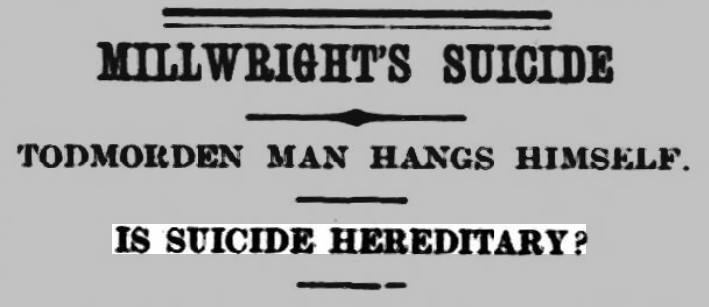
An inquest into Rose’s death was held at Todmorden town hall on Nov 17, 1899, the day after her death, and it was reported in the Todmorden and District News: ‘Todmorden drowning case probable suicide. During the breakfast half-hour Monday morning great excitement prevailed in the neighbourhood of the Golden Lion bridge, capitalise Todmorden, by reason of a report that the dead body woman had been found floating in the canal and the sensation was increased by the fact that deceased’s husband appeared on the scene before the body had been recovered and actually assisted in getting the lifeless form out of the water. The deceased was Rose Gibson, aged 54 years, wife Richard Gibson, millwright, of 5, Longfield Rd Todmorden. She was very well-known in Todmorden district, being at one time the landlady of the York Hotel.The body was at once removed to 5, Longfield Rd Todmorden.
In matters such as this rumours of a somewhat ugly character soon ran rife in the town but the verdict was: “Found drowned, without mark of violence or injury, having probably drowned herself, but not sufficient evidence to show the state her mind the time.” Richard’s testimony was that the couple woke around 5:30 on the morning in question. Rose got up saying she was going to make some cocoa. That was the last he saw of her. When he got up about 7:30 she was not in the house and so he went to search for her, first calling in at her daughter’s house, thinking she might be there. But to no avail. He went back home to see if she’d returned but she had not. He set off again in search and when he got to the Golden Lion Bridge he heard that there was woman in the canal lock at Neddy Bridge.. He went to look, and found it was his wife. He recognised her by her hair and shawl. She was only a couple of hundred yards from her home. Despite five or six people gathered around Richard testified “I had to ask four or five times before they would put a hand on.” On being asked if she had ever hinted at taking her own life Richard replied “Well, she has sometimes said she would: she told me on Sunday that she had been a bit queer at times ever since the change of life. She has also been a hit upset about letter from a niece in Middleton. The Coroner: Has she been taking too much drink lately? Well, Sunday night she wanted a pint bottle for beer, and I fetched her one from the White Hart.”
So off I went in search of the canal lock at Neddy Bridge, scene of her death and Rose’s home at Longfield. I couldn’t locate Neddy Bridge on a map but by posting for help on FaceBook I found that that particular lock on the Rochdale canal is directly opposite the Golden Lion. The lock had taken its name from a former landlord and coach proprietor at the Golden Lion – Owd Neddy Blomley. From my home in the centre of Hebden Bridge I walked the four miles along the Rochdale canal to Todmorden. Mallard ducks and Canada geese accompanied me along the towpath, honking vociferously for this was Spring and thus the height of mating season. Fragments of former houses and mills edged the towpath from time to time, their stones covered with bright green moss, and I liked to imagine it was the hair of some wonderful canal monster.

At Callis gardens the vegetable beds were springing into life and early crocuses were adding splashes of yellow in the flower pots displayed on the roof of the houseboats moored on the canal. Stoodley Pike topped the hills to my left while the Wizard of Whirlaw dominated my view to my left. As I approached the town of Todmorden I could see Cross Stone church atop the hill and I thought about Stansfield’s wedding there one hundred and fifty years ago. Along the towpath’s edge herb gardens had been planted, part of the Incredible Edibles, an urban gardening project started in Todmorden in 2008 that aims to bring people together through actions around local food. In 2009 Prince Charles visited the project to give his support and since its beginning 700 similar groups have sprung up worldwide. Just before Neddy Bridge a large sign with letter 5 ft tall is set into a wall above the marina. It spells the word Kindness.

Running beneath the bridge a steep cobbled footway connects the towpath to the main road. I was in search for Rose and Stansfield’s home at the time of her death – 5, Longfield Road. Longfield Road rises steeply from the main road where it crosses the canal at the Golden Lion. On my right was Cockpit, home of Ellen Maria Farrar who had assisted in the laying out Rose’s body after it was taken from the lock. Today a lady was gardening outside Cockpit in the early morning sunshine and I explained the reason for my presence and we mulled over Rose’s story together.
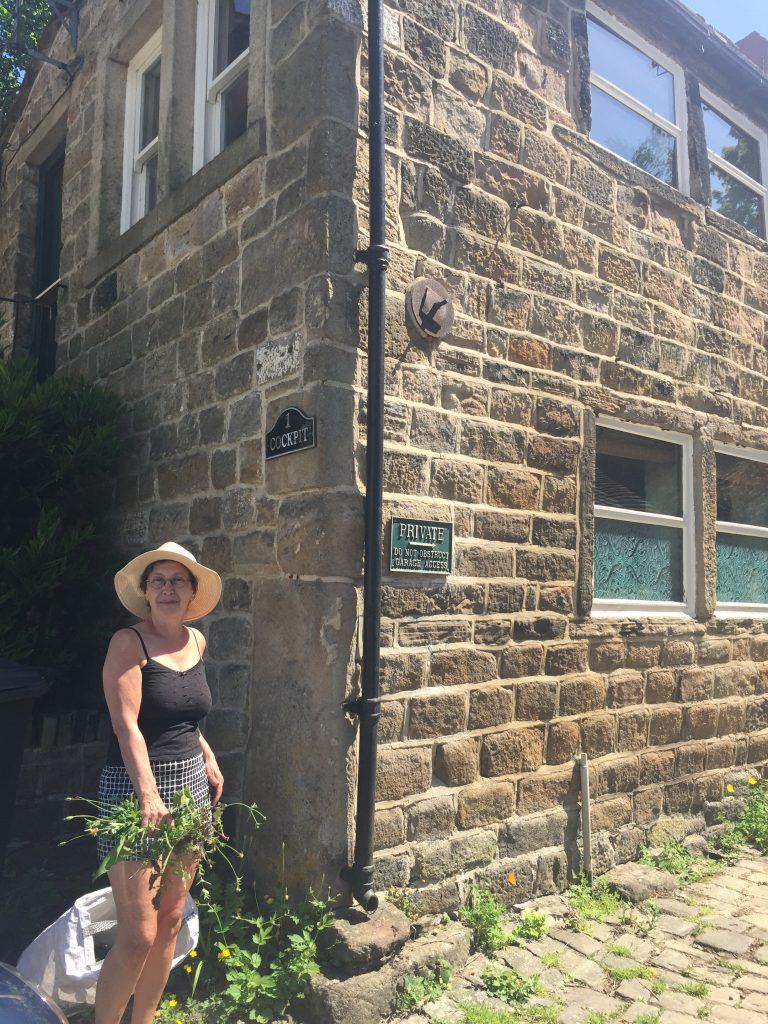
As I sought out the house numbers on Longfield Road I realised that number 5 no longer exists. Judging from a retaining wall above the canal and the long flight of steps that must once have been a terrace of houses that in Rose’s time overlooked the Golden Lion inn and the canal I realised that the word Kindness is on the very spot where Rose and Stansfield’s house had been. A few weeks later I happened to see two photos spanning one hundred years superimposed on one another in an estate agent’s window in Todmorden.

The end result was that the author/photographer, Daniel Birch, delivered his book ‘Todmorden Now and Then’ to my door. Imagine my surprise when leafing through I found two photos superimposed of the old and the new view of where I suspected Rose’s house had been. And there it was, in a terrace of four storey houses directly above the canal and Daniel confirmed that ‘the steps leading to Longfield Road are still in place.’
My next stop was the Golden Lion, where, just to confuse things, Richard’s third wife had been living when she married Richard. It is primarily a live music venue of considerable repute. I was rather taken aback by the bright yellow coat of paint that has recently come to adorn the side wall, a rather bright gold, dare I say garish?
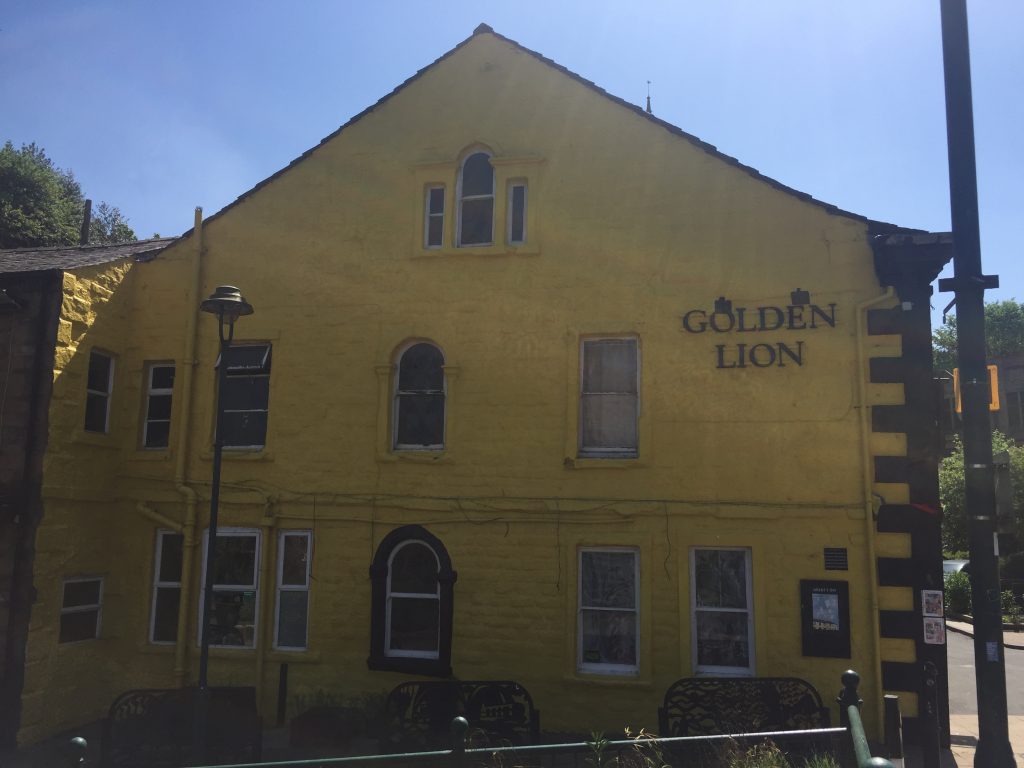
The current owners have been threatened with a £20,000 fine and even jail for painting the exterior wall this obtrusive colour. The Guardian and The Independent have both taken up the story in which the owner says it was done after the council asked local businesses to brighten up the town in the face of the pandemic. Six months later I returned to the scene and saw that the wall has now returned its former white hue. I looked in vain for a golden lion too but found instead a little outdoor street market, redolent of the strong sense of community that is prevalent in Todmorden. Built as a coaching inn around 1760 the Golden Lion inn was a halt on the Manchester to Halifax stage coach service. Many important meetings have taken place over a few glasses of ale in here and I was sad not to be able to sup a glass in Rose’s memory today in such historic surroundings. High on the list of significant meetings held here was one which resulted in the proposal to erect Stoodley Pike, a monument marking the end of the Napoleonic Wars. Its erection was first discussed in this very pub in 1814. Six years later the first meeting of a new company established to built [build] the amazing edifice of Todmorden Town hall was held here too. Today The Golden Lion is known as one of the small market town’s most haunted buildings. It runs UFO-spotting meetings and patrons sometimes stay overnight in the upstairs room, provided they provide their own sleeping bags—and a fair dose of skepticism.
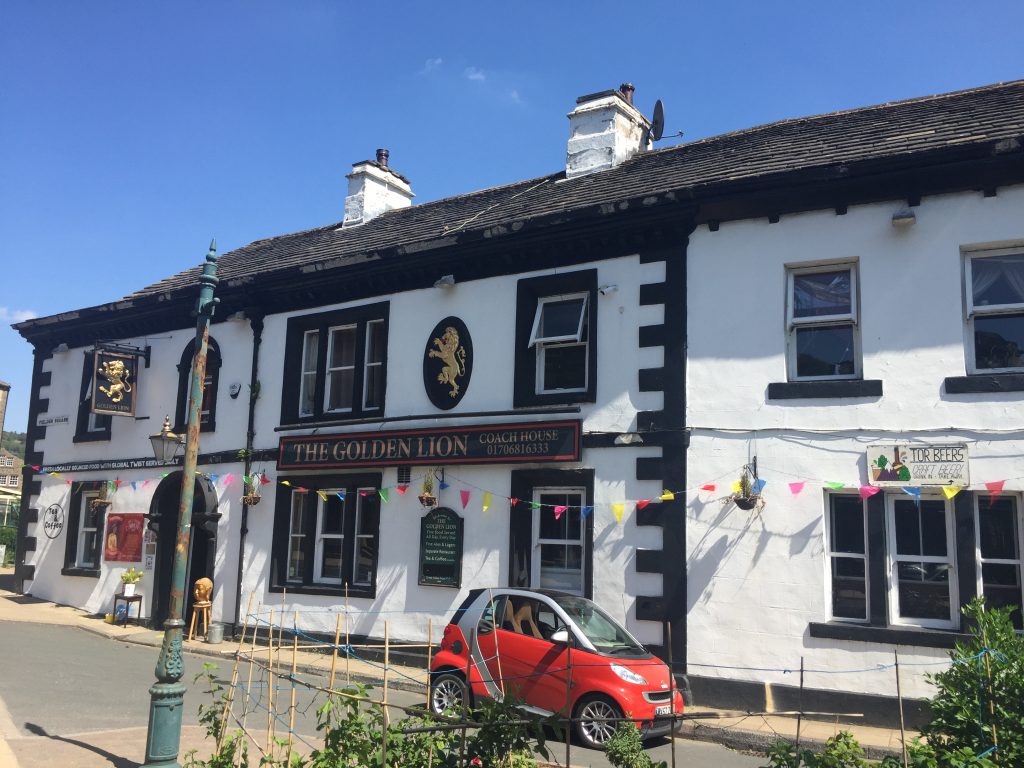
Before I went to pay my respects to Rose I needed to know more about her life and to do that I had obtained her marriage certificate since Stansfield appeared to be her married name. Once that was in my possession I was able to piece together something of Rose’s story. Rose had been born in Mickleover, Derbyshire. Just two miles West of Derby the quaintly named village played an important part in the industrial revolution for it was there in 1717 that the world’s first industrial scale textile factory, a silk mill, was built. It’s cutting edge technology caused it to become quite a tourist attraction and both Daniel Defoe and Benjamin Franklin visited the mill. Rose’s father, Thomas had been a silk weaver but like many of the families around the area he was a silk weaver working with a hand loom, not the silk factory. Rose was the first of five children born to William and Harriet (nee Ambrose) and she arrived in the world just two months after her parents had been married at the parish church in Mickleover. In the early 1850s the family moved 85 miles north to Tonge in Lancashire, close to Rochdale and on May 6, Rose married Joseph Bamford, a 21 year old labourer living in Tonge. A daughter and son were born to them but in the winter of 1871 when only 30 years old Rose became a widow. It took her 8 years to find another husband, this time marrying John Stansfield, a bachelor living in Todmorden and several years younger than Rose. John was a master whitesmith like his father and employed a few other men and boys. A whitesmith was a metalworker who did finishing work on iron and steel such as filing or polishing, a much needed skill in the factories of the industrial age when small intricate parts constituted the large machinery. They set up home together at 4 Eagle Street in Todmorden with Rose’s daughter Sarah Bamford, moving to 1 Raglan Street, the next street, some time before 1891.

Of course all this time I had been wondering what precipitated Rose’s untimely death and perhaps an article in the local newspaper may give some insight into Rose’s predicament. In 1893 Rose took John Stansfield to court for deserting her. The account of the trial is a harrowing one. John had been ill for twelve months suffering from dropsy and Bright’s disease. For the previous month he had been bedridden and unable to go to his place of work in Der Street where he employed five or six men in his whitesmithing business. Rose had nursed and attended to him throughout his illness providing him with beef tea, milk, bread and mutton chops. His friends had looked in from time to time to cheer him up and had brought with them whiskey, brandy and even a bottle of champagne on one occasion. On Friday evening January 20th Rose went to bed about quarter past eleven and bade John goodnight ‘on the best of terms.’ About 5:30 in the morning she went downstairs and found that her husband had gone.’ 24 Not only her had left but the bed to which he had been confined had also gone! Rose ran the short distance to Eagle Street where John’s two brothers and two sisters lived together and was told that John was with them but she was not allowed to enter. The prosecution brought evidence that Rose had not properly cared for her husband and that she had consumed the liquor meant for him. John’s friends had had to pick her up off the floor, so drunk was she, and they had made the decision to remove him from the house. The court ruled that since John could no longer work because of his illness he had insufficient means to support Rose financially and though he had sent one month’s rent to their Raglan Street landlady, he would be unable to give her a weekly allowance. The case was dismissed. John died four months later at his brother’s house, 4 Eagle Street. Rose moved in to live at the masonic hall in the centre of Todmorden with her daughter and son-in-law, presumably as the caretaker.

She was still living there when she married for a fourth time, in the Todmorden registry office on September 19, 1898, this time to Richard Gibson and so it is at this point that she enters my family tree. So, after walking past the Town Hall where the inquest into Rose’s death took place I headed to the masonic hall. This imposing building is opposite the White Hart Inn that played such a pivotal role in my family’s story for it was in that building that the bastardy court was satisfied that James Wrigley of Lily Hall was indeed the father of Elizabeth Ann Whitham, and it’s through her birth that all my ancestors in this story can be traced.
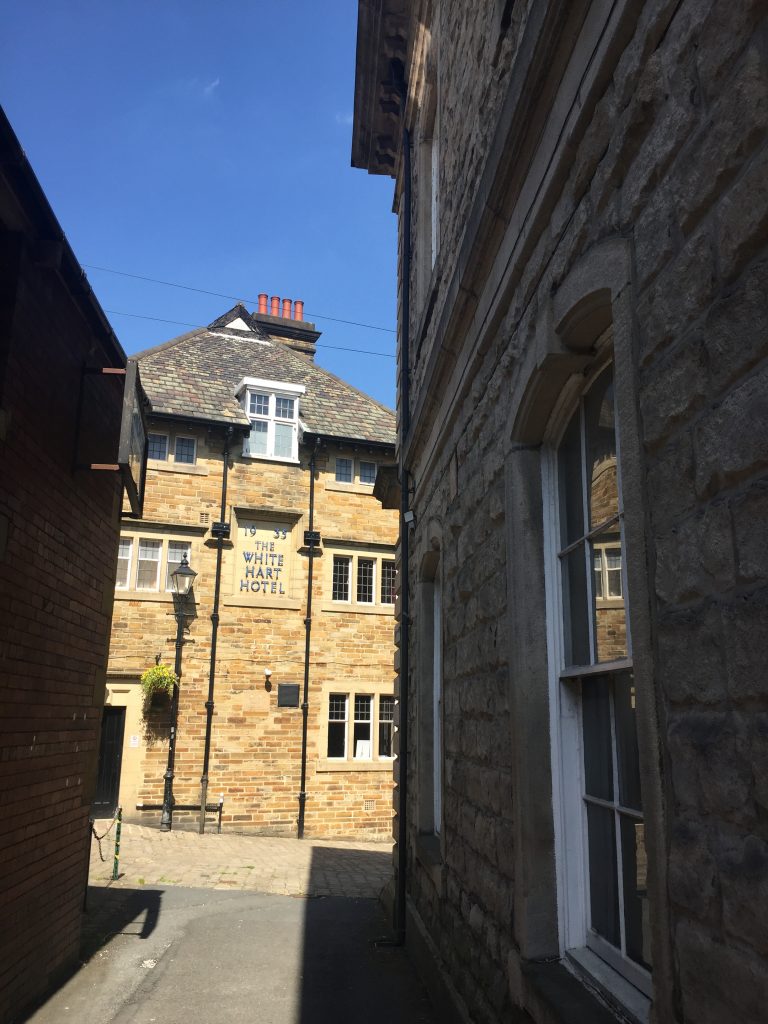
It was from this pub that Richard brought Rose her final pint of beer. Before I knew of any connection between this pub and my family my daughter Sarah and I had had lunch there when we were visiting Calderdale in June, 2017. The masonic hall was built in 1862 and is a Grade ll listed building. Today as I looked at it for the first time I see that is a very substantial building but it currently looks disused. From the masonic hall it was only a couple of minutes walk to my final stop in Rose’s story: the canal lock itself. I realised that overlooking the lock is the garden of House des Lowe, a cafe I frequent in ‘normal’ times which is owned by my textile teacher and her husband. I’ll never again be able to sit enjoying my coffee in their rose bedecked garden without thinking about my own Rose. I took a few photos as I stood beside the lock, thinking about that morning 120 years ago.
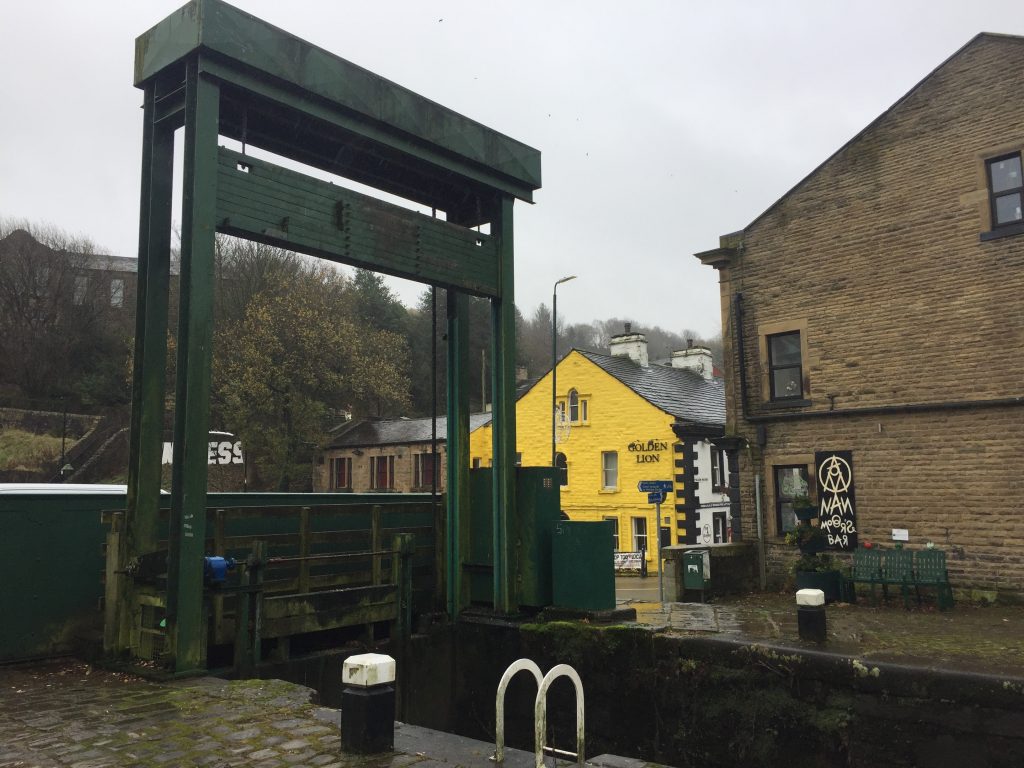
“Don’t go jumping in now,” quipped the man sitting on the bench beside me giving me a strange look.
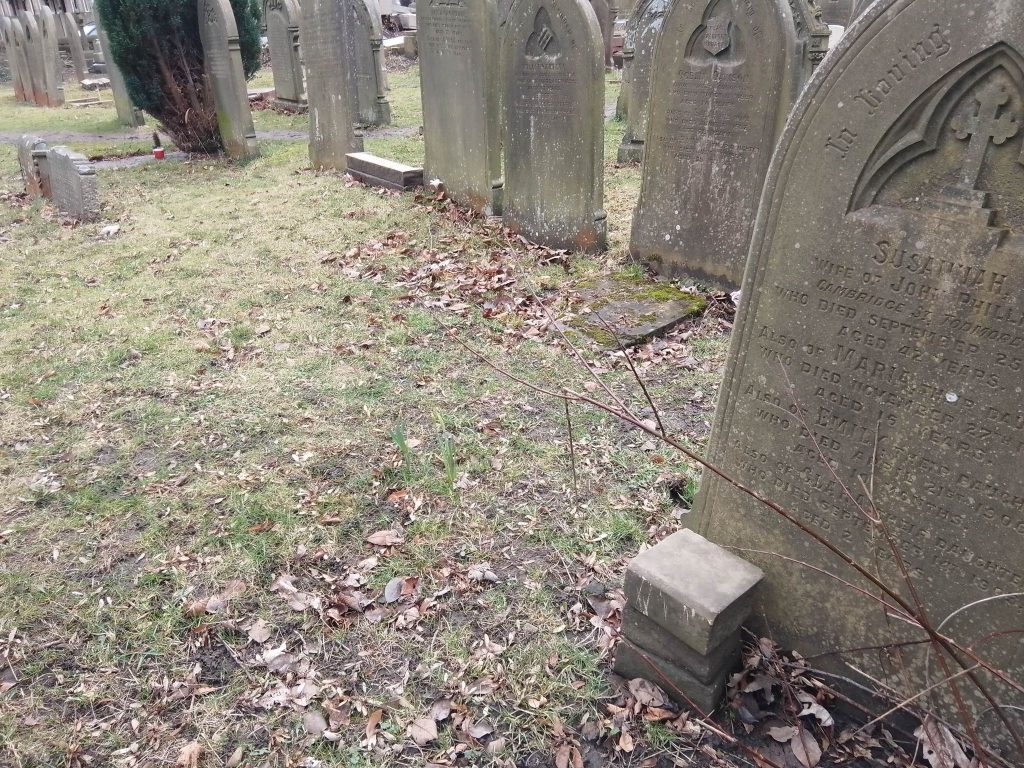

Richard was 69 when he hanged himself in the staircase of his home at 17 Union Street. Today only the street sign remains. The rest of the terraced street was demolished in the 1970s.
RICHARD GIBSON
Todmorden & District News – Friday 29 July 1910: IS SUICIDE HEREDITARY? At Todmorden Town Hall, on Monday morning, Mr. E. H. Hill, coroner, held an inquiry concerning the death of Richard Gibson (69). millwright, of 17, Union Street Todmorden, who had been found hanging his residence on Sunday night. Mr. Richard. Dewhirst was chosen foreman of the jury. Sarah Gibson, the widow, was the first witness. She said her deceased husband was 69 years of age The Coroner: Had he been drinking lately ? ?Witness: Just a little. When? On Friday and Saturday. Did he bring the drink into the house with him? No, sir. What was he doing on Sunday ? Laying in bed most of the day. He came downstairs two or three times to have a smoke. Did he have anything to eat? No, only a drink of cocoa. When did you last see him alive ? Just turned half-past six at night. Where was he then? Upstairs, laid on the bed, partly dressed. He asked me where I was going (he saw that I had clothes on ready for going out), and I told him I was going to his daughter’s house. Did he seem cheerful? No, he was very quiet all day. And then you went out? Yes. I locked the house door and went out, and got back at half-post seven. And what did you find? l shouted Are you coming downstairs? but there was no reply. Then I called out again, but he did not answer, so I went to the bottom of the stairs, and saw bis legs hanging down the staircase, and I ran out for help. Who cut the body down? Mr. Hanbury came in first. But your husband was quite dead, I suppose? Yes, sir. Had you had any trouble? Well, he had had bit of bother in the public house with man on Saturday night, and the man threatened to summon him, and sent him a letter. That seemed to prey on his mind. Had he ever threatened anything of this kind? No, sir. Has he ever been in an asylum ? No, sir. Or any of his relatives? Not to my knowledge. Have any of his relatives committed suicide? Yes, his father committed suicide. At about the same age, wasn’t it?Well, I think so. The Foreman: Hadn’t he a daughter who committed suicide? Yes, his last wife did also. John Hanbury, an out-door labourer, of 15, Myrtle-street, Todmorden, said be knew deceased. Coroner. l was just coming out of my lodgings on Sunday evening about half-past seven when I met Mrs. Gibson. She said her husband was trying to hang himself. I ran to the house and found him hanging in the staircase. The Coroner, in summing up, said he presumed the jury had no doubt deceased hung himself. The next question they ‘had to decide was whether there was sufficient evidence to show what was the deceased?s condition of mind. He was bound to say that in great many of the cases which had to investigate either some of the relations had been insane or had committed suicide. When they found there had been two or three suicides in family it was certainly some evidence that there was strain of insanity in that family; and doctors had found that in the case of such families a suicidal tendency showed itself at a certain age. Were the members of the jury satisfied deceased hung himself, and was there sufficient evidence to determine the state of his mind at the time. The Foreman said he thought there was little doubt that deceased was temporarily insane. His wife said had received a threatening letter which preyed on his mind somewhat. The Coroner: Yes, but the same time a letter of that kind would not upset the reason of man with thoroughly sound mind. A unanimous verdict was returned to the effect that deceased committed suicide whilst of unsound mind.
Leave a Reply